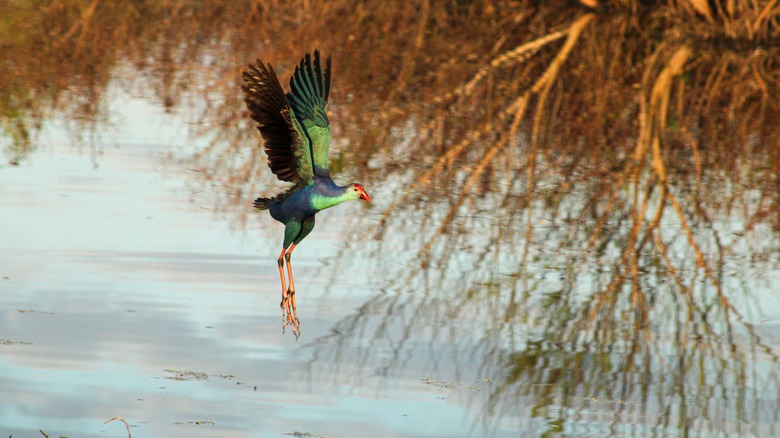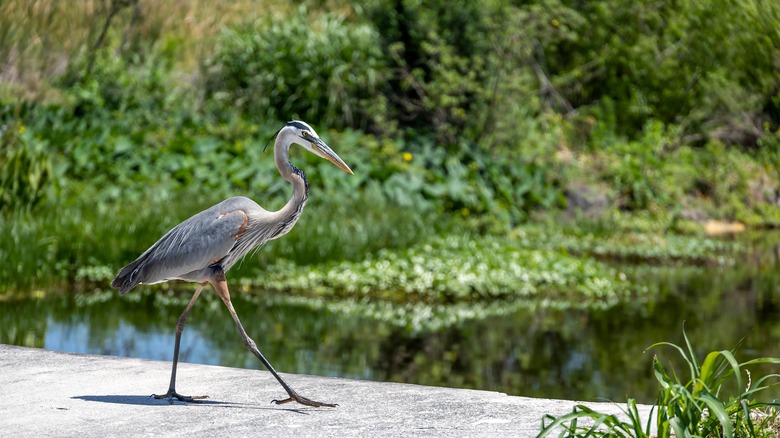Florida's Underrated Shorefront Is A Diamond-In-The-Rough Lake Brimming With Wildlife And Beauty
The idea of a Florida waterfront probably brings to mind the white sand shores of the Gulf Coast, like Siesta Key in Sarasota, one of America's best beaches, or the bustling Art Deco backdrop of Miami Beach's Ocean Drive. By contrast, the state's central region is better known for theme parks and family-friendly resorts sprawled across the area. However, just 12 or so miles north of Orlando is an underrated shorefront: Lake Apopka. At nearly 31,000 acres, it is Florida's fourth-largest lake. This revived wildlife-rich body of water is fed by natural springs and is known for its lush shoreline on the north side, with access to fishing, boating, hiking trails, and the 11-mile Lake Apopka Wildlife Drive — a fantastic place to spot alligators and birds.
Lake Apopka is pronounced how you'd likely expect it to be — "uh-POP-kuh." The word comes from the Apopkans, a tribe that predated the Seminole, and roughly translates to Big Potato, Potating-Eating People, or Potato-Eating Place. Settlers arrived in the mid-1800s and cultivated crops like cotton and oranges, which thrived with all the clear and abundant water. The lake was also famous for world-class fishing.
In the 1940s, the fertile mud around the lake was drained by a levee to create more farmland. Water quality declined, and the lake became one of Florida's most polluted, overloaded with toxic algae and phosphorus from agricultural runoff. In the 1980s and 1990s, the lake was earmarked for extensive cleanup, and today it's a revitalized wildland, considered a "diamond in the rough."
Drive, hike, boat, or ride through restored wetlands
The North Shore of Lake Apopka has become an eco-tourism hub as farmlands are gradually restored to wetlands, where visitors can access four trailheads for walking, cycling, horseback riding, permitted fishing, and boat ramps for launching watercraft. While a trail that fully circles the lake is still in development, the current 20-mile Lake Apopka Loop Trail is an out-and-back route covering the lake's northern half, with restrooms and a historic pumphouse. Potable water isn't provided, so bring your own! Several multi-use trails traverse nearby Clay Island, with four observation towers perfect for birdwatching.
One of the area's most popular features is the Lake Apopka Wildlife Drive: a free, one-way gravel loop providing incredible, up-close views of wetland wildlife — birds of all kinds, alligators, turtles, butterflies, and more. The drive starts at Lust Road and ends at Jones Avenue, and can take anywhere from 1 to 3 hours — depending on pace and stops. Along the way, you'll find scenic pullouts where you can pull over to observe wildlife, and a QR code linking to an optional audio tour. The road is open Fridays, Saturdays, Sundays, and federal holidays from 7 a.m. until 5 p.m.
Not far from Lake Apopka's northeastern shore is the tiny, under-the-radar city of Apopka — known as "the indoor foliage capital of the world" for its world-renowned commercial fern industry. Head there for a post-hike cocktail or meal after your wildlife adventure, or drive a little further southwest around the lake to Montverde, a charming lakeside town with a rich history. And hey — if you're still craving adrenaline after all that, Orlando and its theme park mayhem is just down the road.

